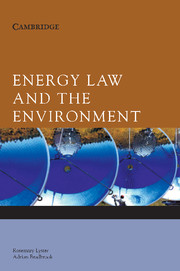Book contents
- Frontmatter
- Contents
- List of figures & tables
- Table of cases
- Table of statutes
- Preface
- 1 Overview of energy production and use in Australia
- 2 Energy technologies and sustainable development
- 3 Energy, international environmental law and sustainable development
- 4 Predicting the RPP for any given year
- 5 Sustainable energy in the Australian electricity and gas sectors
- 6 State government initiatives on energy and the environment
- 7 A sustainable energy law future for Australia
- Appendix A Draft non-legally binding Statement of Principles for a Global Consensus on Sustainable Energy Production and Consumption
- Appendix B Draft Protocol on Energy Efficiency and Renewable Energy to the United Nations Framework Convention on Climate Change
- Index
2 - Energy technologies and sustainable development
Published online by Cambridge University Press: 05 June 2012
- Frontmatter
- Contents
- List of figures & tables
- Table of cases
- Table of statutes
- Preface
- 1 Overview of energy production and use in Australia
- 2 Energy technologies and sustainable development
- 3 Energy, international environmental law and sustainable development
- 4 Predicting the RPP for any given year
- 5 Sustainable energy in the Australian electricity and gas sectors
- 6 State government initiatives on energy and the environment
- 7 A sustainable energy law future for Australia
- Appendix A Draft non-legally binding Statement of Principles for a Global Consensus on Sustainable Energy Production and Consumption
- Appendix B Draft Protocol on Energy Efficiency and Renewable Energy to the United Nations Framework Convention on Climate Change
- Index
Summary
The Brundtland Report in 1987 described ‘sustainable development’ as development that ‘meets the needs of the present without compromising the ability of future generations to meet their own needs’. In a comprehensive joint study in 2000 of the link between energy use and production and sustainable development, the United Nations Development Programme, the United Nations Department of Economic and Social Affairs and the World Energy Council declared in their report, World Energy Assessment: Energy and the Challenge of Sustainability (hereafter referred to as World Energy Assessment) that there are two important features of the link between energy production and use and sustainable development:
One is the importance of adequate energy services for satisfying basic human needs, improving social welfare, and achieving economic development – in short, energy as a source of prosperity. The other is that the production and use of energy should not endanger the quality of life of current and future generations and should not exceed the carrying capacity of ecosystems.
In its chapter on energy resources and technological development, the World Energy Assessment went on to consider the appropriate options available for using energy in ways supportive of sustainable development consistent with addressing environmental concerns. The report identified three major options:
Greater use of energy efficiency, in terms of energy use in buildings, electric appliances, motor vehicles and industrial production processes.
Increased reliance on renewable energy resources.
Accelerated development of new energy technologies, in particular next-generation fossil fuel technologies. Nuclear technologies could also be included if the environmental problems associated with nuclear energy could be resolved.
- Type
- Chapter
- Information
- Energy Law and the Environment , pp. 10 - 33Publisher: Cambridge University PressPrint publication year: 2006



